| by Trent Pheifer | ||
| [ Note: This article originally appeared in Issue 54 of Voyage, the quarterly journal of the Titanic International Society. ] |
||
|
New York has been at the center of the North American shipping industry since the 1820’s, when the United States built the Erie Canal. It connected the Atlantic Ocean to the Great Lakes by way of the Hudson River, which borders New York City to the west. New York City’s economy began to boom as the gateway to the Midwest. Before the canal, New York City was the fifth busiest port. Within 15 years, it had become the busiest, exporting and importing many of America’s goods. Along with the many cargo ships that would stop in New York, passenger lines such as White Star began making it their American port-of-call. It was cheaper for those immigrants who wanted to settle further inland to stop in New York than travel further westward by way of the canal. New York was Titanic’s destination when she sank in the North Atlantic, taking with her over 1,500 souls. The remaining 705 made it to New York aboard Carpathia. Chelsea Piers • Piers 54 and 59 • Hudson River from 13th to 18th Street At the turn of the century, New York City looked to revitalize an area on the Hudson River that had become rundown and unattractive; the Chelsea Piers were the answer. Warren and Wetmore, the same architects who designed Grand Central Terminal, designed this massive project. It consisted of nine piers ranging from 350 feet to 825 feet long and 125 feet wide. They covered the waterfront from 12th Street to 23rd Street. The piers’ head houses had arched gateways and were made of granite with a pink granite facade; green iron sheds were built on the piers’ bases. Large doors lined both floors’ exterior walls, and cargo hoists were placed atop the piers. Before construction could begin, one major obstacle had to be overcome: To build this length of pier it would be necessary to extend the pier head line 200 feet offshore. This the United States government refused to allow, and so the city had to buy property inshore and lengthen the piers by moving the bulkheads inland. The river along the inshore section was dredged to a depth of 40 feet at mean low water. A strong bulkhead was built for 3,600 feet, “nearly the whole distance of the new improvement,” according to The New York Times, Feb. 29, 1910. |
||
 Photo courtesy Dave Shuttle and Barb Shuttle |
| On close inspection, one can still read the words “Cunard Line,” superimposed over the words “White Star Line,” just beneath the arch of the entrance to Pier 54. |
|
By 1990, most of the Chelsea Piers’ sheds had been torn down. Pier 54 and the pier house for Pier 53 were all that was left; both were in danger of being torn down. The piers had not been maintained over the years and some believed they were unsafe and beyond repair. Many fought the historic piers’ demolition, believing they could be turned into a ferry terminal, museum or open exhibition area. Preservationists formed The Committee to Save Cunard Piers. They advertised in The New York Times and sought local support, but it was too little, too late. In July 1992, the Blandford Land Cleaning Corporation began the $1.6 million demolition of Pier 54’s shed and granite front. Another historical building had been lost in New York; some even compared it to the demolition of Pennsylvania Station. The Titanic Lighthouse • Park Row bordered by Pearl, Beekman and Fulton Streets Plans for this memorial were well underway by the end of April 1912. The Seaman’s Benefit Society took charge of raising money for the lighthouse almost immediately following the disaster. The lighthouse would be fixed atop of the new Seaman’s Church Institute, then under construction, at the corner of South Street and Coenties Slip. Wireless Operators’ Memorial • Battery Park The New York Times, which believed New York City should create a memorial to honor Jack Phillips, originally suggested this memorial. On April 30, 1912, the Maritime Association of the Port of New York and the Maritime Exchange met to discuss the idea and create a plan. It was decided the memorial would not honor just Phillips, but all wireless operators lost while doing their duty. Afterwards The New York Times began the Marconi Wireless Operators’ Fund; much of the money collected came from actual wireless operators who admired Jack Phillips. The fund would also provide financial aid to the widows and orphans of lost operators. |
 Photo courtesy Dave Shuttle and Barb Shuttle |
 Photo courtesy Trent Pheifer |
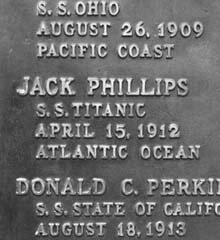 Photo courtesy Dave Shuttle and Barb Shuttle |
| The Wireless Operators’ Memorial (center) is dedicated to the many wirelss operators who lost their lives at sea, as engraved in the upper portion of the monument (left). Titanic’s wirelss operator Jack Phillips’ name is prominent on the base of the memorial (right). | ||
|
On May 12, 1915, the memorial was ready for its unveiling. The fountain was draped in the American flag and crowned with a wreath. Despite the rain, over 500 people turned out for the ceremony. Acting Mayor McAneny spoke of the heroism of the wireless operators and mentioned that the two wireless operators who had lost their lives on Lusitania five days earlier would be remembered on the monument. Following his speech, the fountain was unveiled. Two buglers sounded Taps as the parks commissioner removed the flag and activated the fountain. Straus Park and Fountain • Bordered by Broadway, West End Avenue and 106th Street As with many of New York’s Titanic memorials, planning for this memorial began almost immediately following the disaster. By late June 1912, over $10,000 had been raised for a fountain and park to honor the Strauses. A triangular park in Morningside Heights, near where the Strauses lived, was designated for the fountain. Its name was changed from Bloomingdale Park to Straus Park soon afterwards. Many objected to the name change because it was the last area in Manhattan that carried the name Bloomingdale, the old name for Broadway and a large portion of Upper Manhattan. |
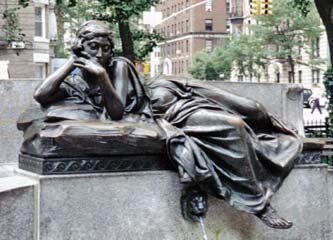 Photo courtesy Trent Pheifer |
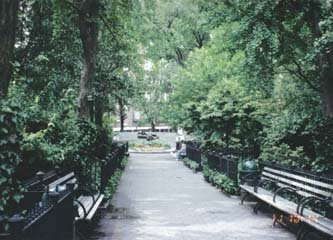 Photo courtesy Trent Pheifer |
| The Straus Fountain (left), located in picturesque Straus Park (right), just off Broadway, was erected to honor the memory of Isidor and Ida Straus, who lost their lives aboard Titanic. |
|
|
It was dedicated in the late afternoon of April 15, 1915 at a well-attended ceremony. The Strauses were well known in New York for their charity work. The ceremony lasted two hours and included Justice Greenbaum, Seth Low and Mayor Michel as speakers. Over 300 children from the Education Alliance, which Isidor Straus founded, sang in praise of the couple. The park was also officially christened Straus Park during the ceremony. Steamship Row • The old International Mercantile Marine Building • 1 Broadway |
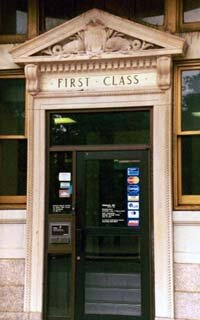 Photo courtesy Dave Shuttle and Barb Shuttle |
 Photo courtesy Trent Pheifer |
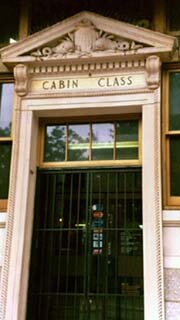 Photo courtesy Dave Shuttle and Barb Shuttle |
| The First and Cabin Class entrances are still prominent in the IMM building at 1 Broadway (center), which is now a Citibank. | ||
|
• The old White Star Line Office • 9 Broadway • The old Cunard Building • 25 Broadway |
 Photo courtesy Dave Shuttle and Barb Shuttle |
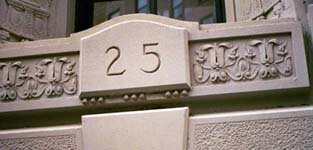 Photo courtesy Dave Shuttle and Barb Shuttle |
| The IMM logo is evident in the intricate ironwork inside 1 Broadway (left), while the Cunard building at 25 Broadway shows the intracacies of early 1900’s architecture (right). |
|
|
Old Institute of Seaman’s Friend • 113 Jane Street • Overlooking the Hudson Many of Titanic’s crew stayed here while being detained for the American Inquiry before it moved to Washington. On the morning of April 19, about half of the 210 surviving crew came here for a memorial service for those lost on Titanic. At this meeting, the collection for the Titanic Lighthouse began. Attendees also received a new set of clothes. On April 20, a group of Titanic’s crew posed on the front steps before boarding the Lapland to return to England. Some years after the Institute of the Seaman’s Friend left the building, it was converted into the Riverview Hotel, which it remains today. The building also houses the Jane Street Theater. You can stay at the hotel quite cheaply ($40 to $74 a night)… although you may have to sacrifice some luxuries, like space or your own bathroom! Astor Window at Cathedral of St. John the Divine • 112th Street and Amsterdam Avenue Construction began on this Cathedral in 1892 and is still underway today. When completed, it will be the largest cathedral in America. On the easternmost bay of the north aisle is the American Hall with a Jamestown Medallion on the floor before it. The stained-glass window, designed by Ernest W. Lakeman and donated by the Astor family, depicts major events in American history and memorializes John Jacob Astor IV with a picture of the sinking Titanic in the lower right corner. Ironically, the stained glass Titanic sports Cunard’s red-and-black funnels. An inscription on a stone below states, “This Window Is Given By The Members Of His Family To The Memory Of John Jacob Astor Who Died Nobly At The Sinking Of The Titanic On April 15, 1912.” |
 Photo courtesy Trent Pheifer |
 Photo courtesy Trent Pheifer |
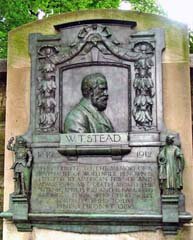 Courtesy of www.maint.com |
| Titanic can be seen in the lower right-hand corner of this stained glass window (left) in the Cathedral of St. John the Divine. The Old Institute of Seaman’s Friend (now the Riverview Hotel) on Jane Street (center) was home to many of Titanic’s surviving crew while waiting to testify at the Senate Inquiry. The W. T. Stead memorial (right) is flanked on the bottom left and right by small figures of “fortitude” and “sympathy.” It is a copy of a memorial on the Thames in London | ||
|
William T. Stead Memorial • Central Park Wall, 5th Avenue across from East 91st Street This bronze tablet was sculpted by Sir George Frampton and was a duplicate of a tablet placed on the Thames Embankment in England. The American Stead Memorial Committee raised funds for its placement. It was unveiled in a brief ceremony on the 72nd anniversary of Stead’s birth, July 5, 1921. The plaque is a bas-relief of Mr. Stead with figures on each side symbolizing fortitude and sympathy. Inscribed is the following: This Tribute To The Memory Of A Edith Corse Evans Plaque • Grace Church • Broadway and West 10th Street On April 22, 1912, a memorial service was held here to remember Miss Edith Corse Evans. In attendance was Caroline Brown, to whom Edith had given her seat because Caroline had children. In late 1912, this plaque was presented to the church in memory of her. Isidor and Ida Straus Elementary School (P. S. 198) • 1700 Third Avenue This light blue building was named in honor of the Strauses; it was the second school in New York named for them. Arlington Hotel • 18 West 25th Street Many of Titanic’s survivors stayed here after arriving in New York. Barbizon Hotel • 140 East 63rd Street Margaret Brown lived here during her final years. She passed away here on October 26, 1932. The name has since been changed to The Melrose Hotel. |
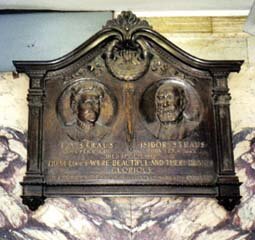 Photo courtesy Trent Pheifer |
 Photo courtesy Trent Pheifer |
 Photo courtesy Dave Shuttle and Barb Shuttle |
| This plaque (left), dedicated to Isidor and Ida Straus, cofounders of Macy’s Department Store, is now practically hidden from view. Margaret “Molly” Brown spent her final years at the Barbizon (now Melrose) Hotel on New York’s East 63rd Street (center). The IMM building at 1 Broadway still boasts its many ports of call with the cities’ crests (right) | ||
|
Carnegie Hall • West 57th Street and 7th Avenue On May 12, 1912, a memorial service was held here in remembrance of the Strauses. Mayor Gaynor and Andrew Carnegie were speakers and mourners filled every seat. A crowd of over 1,000 gathered outside the hall, standing in the rain, to remember the Strauses. Other Titanic-Related Places Titanic International Society has dedicated several plaques to the Titanic’s passengers around the city: The Unknowns • Isidor and Ida Straus plaque in Macy’s • 34th Street and 7th Avenue • Center entrance on 34th Street Lost Places • The old Waldorf-Astoria Hotel |
||
 New York’s early morning papers on Monday, April 15 had much of the city talking Titanic. Most papers had taken the safe route and reported that Titanic was injured but safe, but Carr Van Anda, managing editor of The New York Times, played a hunch. He believed the abrupt stop in Titanic’s wireless communication meant she had sunk. He decided to report this on the Times’ front page. Crowds gathered at the White Star Line office at 9 Broadway inquiring about the ship and her passengers. Through a spokesman, P. A. S. Franklin assured them Titanic was safe and that the Times’ reports were unfounded.
New York’s early morning papers on Monday, April 15 had much of the city talking Titanic. Most papers had taken the safe route and reported that Titanic was injured but safe, but Carr Van Anda, managing editor of The New York Times, played a hunch. He believed the abrupt stop in Titanic’s wireless communication meant she had sunk. He decided to report this on the Times’ front page. Crowds gathered at the White Star Line office at 9 Broadway inquiring about the ship and her passengers. Through a spokesman, P. A. S. Franklin assured them Titanic was safe and that the Times’ reports were unfounded.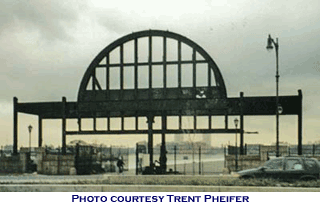 In 1907, five years after construction began, the pier bases were completed and Mauretania and Lusitania began using Pier 54. It took another three years for the sheds to be built on the bases. The piers were officially opened on February 11, 1910; White Star’s Oceanic broke the ribbon stretched from Pier 61 to Pier 62 when she was moved from Pier 48. The entire project cost the city $25 million.
In 1907, five years after construction began, the pier bases were completed and Mauretania and Lusitania began using Pier 54. It took another three years for the sheds to be built on the bases. The piers were officially opened on February 11, 1910; White Star’s Oceanic broke the ribbon stretched from Pier 61 to Pier 62 when she was moved from Pier 48. The entire project cost the city $25 million. The memorial includes a time ball, which was used daily when the lighthouse sat atop the Seaman’s Church Institute building.
The memorial includes a time ball, which was used daily when the lighthouse sat atop the Seaman’s Church Institute building. In February 1914, a new emergency wing ward was dedicated to Dr. William Francis Norman O’Loughlin, the doctor who went down with the Titanic. He often visited the hospital to attend to the seamen. “A bronze tablet inscribed with his name will be placed in the hall outside the ward facing the small chapel where the sisters meet to go through their daily spiritual exercises.” It was originally proposed that a laboratory be built on the roof to honor O’Loughlin, but that did not comply with the requirements of the Building Bureau. When it opened, the ward consisted of “three separate rooms, one for general usage containing nine beds, one with three beds for patients in delirium, and the third with five beds to provide for an overflow or for women patients when necessary.”
In February 1914, a new emergency wing ward was dedicated to Dr. William Francis Norman O’Loughlin, the doctor who went down with the Titanic. He often visited the hospital to attend to the seamen. “A bronze tablet inscribed with his name will be placed in the hall outside the ward facing the small chapel where the sisters meet to go through their daily spiritual exercises.” It was originally proposed that a laboratory be built on the roof to honor O’Loughlin, but that did not comply with the requirements of the Building Bureau. When it opened, the ward consisted of “three separate rooms, one for general usage containing nine beds, one with three beds for patients in delirium, and the third with five beds to provide for an overflow or for women patients when necessary.”